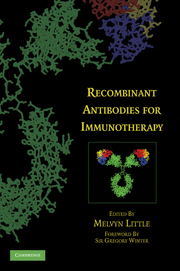Book contents
- Frontmatter
- Contents
- Contributors
- Foreword by Sir Gregory Winter
- Preface
- RECOMBINANT ANTIBODIES FOR IMMUNOTHERAPY
- PART I HUMANIZED ANTIBODIES
- PART II GENERATION AND SCREENING OF ANTIBODY LIBRARIES
- PART III TRANSGENIC HUMAN ANTIBODY REPERTOIRES
- PART IV ANTIBODY EFFECTOR FUNCTION
- PART V ARMING ANTIBODIES
- PART VI NOVEL ANTIBODY FORMATS
- PART VII ANTIGEN-BINDING REPERTOIRES OF NON-IMMUNOGLOBULIN PROTEINS
- PART VIII PROLONGATION OF SERUM HALF-LIFE
- PART IX INNOVATIVE IMMUNOTHERAPEUTIC APPROACHES
- PART X MARKET OVERVIEW AND OUTLOOK
- Index
- Plate section
Foreword by Sir Gregory Winter
Published online by Cambridge University Press: 15 December 2009
- Frontmatter
- Contents
- Contributors
- Foreword by Sir Gregory Winter
- Preface
- RECOMBINANT ANTIBODIES FOR IMMUNOTHERAPY
- PART I HUMANIZED ANTIBODIES
- PART II GENERATION AND SCREENING OF ANTIBODY LIBRARIES
- PART III TRANSGENIC HUMAN ANTIBODY REPERTOIRES
- PART IV ANTIBODY EFFECTOR FUNCTION
- PART V ARMING ANTIBODIES
- PART VI NOVEL ANTIBODY FORMATS
- PART VII ANTIGEN-BINDING REPERTOIRES OF NON-IMMUNOGLOBULIN PROTEINS
- PART VIII PROLONGATION OF SERUM HALF-LIFE
- PART IX INNOVATIVE IMMUNOTHERAPEUTIC APPROACHES
- PART X MARKET OVERVIEW AND OUTLOOK
- Index
- Plate section
Summary
Antibodies were discovered in 1890 but remained on the periphery of the pharmaceutical industry for more than 100 years. Yet within the last 15 years, a succession of antibodies has been approved for therapy by the United States Food and Drug Administration (FDA). Unlike natural antibodies which are polyclonal and directed against infectious disease, almost all those approved by the FDA are monoclonal antibodies directed against human self-antigens and used for treatment of cancer and diseases of the immune system.
Two major breakthroughs proved necessary to launch this antibody revolution. The first breakthrough was rodent hybridoma technology in the 1970s. Antibodies could now be made against single antigens in complex mixtures and used to identify the molecular targets of disease. In some cases this allowed disease intervention by blocking the antigen or by killing a class of cells (such as cancer cells) bearing the antigen. However, hybridoma technology provided only part of the solution; the rodent antibodies proved immunogenic and often did not trigger human effector functions efficiently. The second breakthrough, in the 1990s, was protein engineering; its application allowed the creation of chimeric and humanized antibodies from rodent monoclonal antibodies; not only were these less immunogenic than rodent antibodies, but they more efficiently triggered human effector functions. These chimeric and humanized antibodies now account for the majority of the currently approved therapeutic antibodies.
Nevertheless the field continued to embrace new technologies and to spawn new approaches, most notably the development of genuine human antibodies in the 1990s.
- Type
- Chapter
- Information
- Recombinant Antibodies for Immunotherapy , pp. xi - xiiPublisher: Cambridge University PressPrint publication year: 2009

